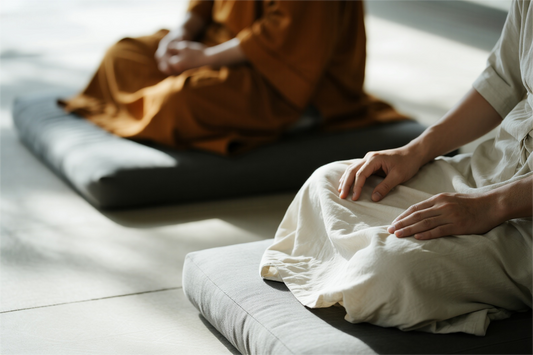
Introduction: The Dance of Wood, Fire, Earth, Metal, and Water
In the rich tradition of Eastern philosophy, harmony is not a fixed state—it is a dynamic balance of forces constantly interacting and transforming. Central to this worldview is the Five Elements Theory—Wood, Fire, Earth, Metal, and Water. These elements are not merely physical substances; they are energetic archetypes that reflect the rhythms of nature and the patterns of human life.
Each element has a corresponding movement, season, organ, color, and emotion. More importantly, they exist in two core relationships:
-
Generating cycle (sheng): Wood feeds Fire, Fire creates Earth (ash), Earth bears Metal, Metal enriches Water (through condensation), and Water nourishes Wood.
-
Controlling cycle (ke): Wood penetrates Earth (roots), Earth absorbs Water, Water extinguishes Fire, Fire melts Metal, and Metal cuts Wood.
This ancient model offers a profound roadmap for personal balance, health maintenance, and emotional well-being. When the five elements are in harmony within us, life flows with vitality. When they fall out of balance, illness and emotional distress often follow.
I. The Five Elements and the Human Body
In traditional Chinese medicine and Daoist philosophy, each element governs specific organs and emotions:
| Element | Organ | Emotion | Season | Direction |
|---|---|---|---|---|
| Wood | Liver | Anger | Spring | East |
| Fire | Heart | Joy | Summer | South |
| Earth | Spleen | Worry | Late Summer | Center |
| Metal | Lungs | Grief | Autumn | West |
| Water | Kidneys | Fear | Winter | North |
A balanced person does not suppress emotion, but flows with its natural expression. For example:
-
Anger (Wood) transforms into growth when directed constructively.
-
Joy (Fire) warms the heart but needs grounding to avoid burnout.
-
Worry (Earth) helps focus but can turn to anxiety if excessive.
-
Grief (Metal) teaches letting go and honoring impermanence.
-
Fear (Water) cultivates caution but must not become paralysis.
Rather than label these feelings as good or bad, the Five Elements approach helps us understand their function and restore internal equilibrium.

II. Five Elements in Daily Life: Eating, Living, Healing
In Southeast Asia, where climate, cuisine, and herbal traditions are deeply rooted in natural wisdom, the Five Elements align beautifully with daily practices of wellness.
1. Dietary Harmony
Local diets naturally reflect elemental principles:
-
Wood (Green, sour): leafy vegetables, lime, tamarind
-
Fire (Red, bitter): chili, turmeric, bitter gourd
-
Earth (Yellow, sweet): corn, pumpkin, bananas
-
Metal (White, pungent): garlic, onion, ginger
-
Water (Black, salty): seaweed, soy sauce, black sesame
By mindfully combining these flavors and colors, meals become not just nutrition—but medicine. A body that receives the full elemental palette stays resilient.
2. Seasonal Adjustments
Even in tropical climates, micro-seasons affect energy. For example:
-
The hot, humid season (Fire) requires cooling herbs and light foods.
-
The rainy season (Water) invites warming teas and kidney-supporting soups.
-
The dry season (Metal) calls for moistening fruits and gentle breathing practices.
Understanding these shifts allows for preventative health, not reactive treatment.
3. Home Environment
The Five Elements also inform interior balance:
-
Wood: plants, bamboo, bookshelves (growth and renewal)
-
Fire: lighting, warm colors, candles (warmth and passion)
-
Earth: pottery, earthenware, stone (grounding)
-
Metal: mirrors, white decor, tools (clarity and structure)
-
Water: fountains, glass, deep blues (calm and introspection)
A balanced home becomes a healing space.
III. Yin and Yang Within the Five Elements
While the Five Elements describe diversity, Yin and Yang explain polarity. Every element contains both yin (inward, cool, dark) and yang (outward, warm, light) aspects.
For example:
-
Wood: Yin = flexibility (bamboo); Yang = assertion (tree growth)
-
Fire: Yin = candlelight (gentle warmth); Yang = wildfire (destructive intensity)
-
Earth: Yin = absorption; Yang = nourishment
-
Metal: Yin = refinement (jewelry); Yang = sharpness (tools)
-
Water: Yin = stillness (pond); Yang = movement (river flow)
Health is the ability to shift smoothly between these states. Emotionally, this means knowing when to express and when to reflect. Physically, it means balancing activity with rest, heat with coolness, stimulation with serenity.

IV. Practical Wisdom for a Balanced Life
Here’s how you can bring Five Elements wisdom into your daily rhythm:
-
Morning Stretching (Wood): awaken the liver, stimulate creativity
-
Midday Sunshine (Fire): recharge joy and cardiovascular strength
-
Afternoon Pause (Earth): digest food and emotion, reflect
-
Evening Breathing (Metal): release tension, honor the day’s end
-
Nighttime Stillness (Water): restore the kidneys, embrace deep rest
You don’t need rituals or complexity—just intentionality. A mindful walk, a well-balanced plate, a calm space—all become acts of alignment.
Conclusion: Flow with Nature, Flow with Life
In the philosophy of the Five Elements, there is no ideal to chase—only rhythms to honor. It is not about controlling health, mood, or fate, but about participating skillfully in the natural flow of things.
To harmonize with Wood is to grow.
To dance with Fire is to shine.
To stand on Earth is to feel rooted.
To shape with Metal is to refine.
To rest in Water is to restore.
And when these elements move in harmony within us, life becomes not a struggle—but a song.
In a world of imbalance and overload, the Five Elements offer a timeless message:
Live seasonally. Eat colorfully. Feel deeply. Rest fully. And above all—balance, don’t battle.




